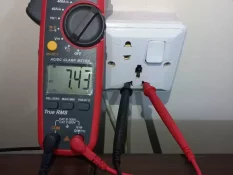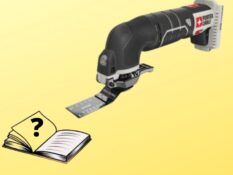A Guide on Choosing the right Impact Driver
Affiliate Disclosure: Handy Tool Adviser is reader-supported. When you buy through links on our site, we may earn an affiliate commission at no cost to you. Read more about our affiliate association here.
How do I choose an impact driver?
In order to make the right choice, you must match the qualities of the tool with your top priorities as well as match the shortcomings of the tool with your acceptable compromises. For impact drivers, following important parameters play important role in making the right choice,
Torque & Power
Torque and power are both the most important factors that determine if your impact driver will get the job done or not. If your use of the tool is for lighter materials such as softwood and removal of low torque screws, even a 1000 in-lbs. will be enough such as Milwaukee 2462-20 that is best for HVAC, sheet metal and woodworking applications at a maximum torque rating of 1000 in-lbs.
However, if your application requires screwdriving into tough materials such as driving construction lags into treated lumber, you must look for higher torque rating more in the 1500-2000 in-lbs. range such as Dewalt DCF887 at 1825 in-lbs. of torque; Milwaukee 2850-20 at 1600 in-lbs. of torque and Makita XDT131 at 1600 in-lbs. of torque.
It is important to highlight here that torque should not be considered as the sole representative of an impact driver’s ability to drive screws into tough materials. Speed and impact per minutes also matter as they assist in driving the screw. Therefore, the overall power of an impact driver can be considered as a combination of torque, RPM and IPM.
Compactness
Compactness plays a very important role in deciding how comfortable you feel with the tool. A compact tool will not only be be easy to carry in hand and hang on your belt but also allow you to work in tight spots.
In impact drivers, a front to back length of under 5.5” and weight of under 2.5 lbs. is a compact design. The most compact tool we found is Milwaukee 1/4" Impact Driver Kit Model M12 Fuel 2553-20 (12 Volt) followed closely by Milwaukee 1/4" Impact Driver Model M18 2850-20 and Dewalt 1/4" Impact Driver Model DCF887.
However, if your use of the tool is occasional, compactness may not be your priority.
Speed Ranges or Operation Modes
Number of operation modes decide how much can the tool adapt to specific jobs. Tools with no speed settings run from 0 to their maximum RPM proportional to the pressure with which you squeeze the trigger. However, controlling a difference of 3-4000 RPM in a trigger squeeze of about an inch depth demands way too much precision from your fingers.
That is why many models have 3 operation modes in which their speed is confined in ranges so that you don’t risk overdriving or driving with too much speed on delicate jobs resulting in stripped screws.
In our research, Milwaukee 1/4" Impact Driver Kit Model M12 Fuel 2553-20 (12 Volt) features 4 operating modes while Dewalt 1/4" Impact Driver Model DCF887 features 3 operating modes to fit to specific jobs.
It is however not recommended to stress on speed settings if your application does not demand versatility. For example, if you are buying an impact driving specifically for let’s say HVAC applications where your primary requirement is to assemble sheet metal HVAC ducts and disassembly of condensers and heat exchangers, you can go with a single speed model best suited for that job such as Milwaukee 1/4" Impact Driver Model M12 2462-20 that runs at 2500 RPM and works best for HVAC applications.
Warranty
When it comes to warranty, you must read the warranty terms clearly before making the purchase. You must go for at least 2 years warranty because that is easily available with majority manufacturers of impact drivers.
Black and Decker impact drivers have 2 years warranty but the catch is that it is valid for home environment only.
DEWALT and PORTER-CABLE are offering a warranty of 03 years for their impact drivers with free replacement of worn out components (covering wear and tear through normal use) for 01 year and a 90 day money back guarantee if the customer is not satisfied with the user experience. This last point is such a big confidence winner that it can easily outweigh a lot of small cons of the machine.
Milwaukee offers warranty of up to 05 years for their impact drivers.
Ergonomic Features
Electric Brake
An electric brake stops the chuck as soon as you release the trigger. It saves a few seconds of your time before you could drive the next screw. A few seconds can save you more than an hour if you are driving screws all day long.
Quick Release Chuck
Gone are the days when you need to grab a tool to fit a bit inside your impact drivers. Modern impact drivers have quick release chucks that allow you to fit the bit inside without the need for any tool.
Dewalt DCF887 and DCF885C1 as well as Porter-Cable PCC641 impact drivers take it one step ahead by designing special chucks to allow single handed bit insertion and extraction.
Although this feature is now common in majority of impact drivers but it is always better to make sure.
Variable Speed Trigger
A variable speed trigger refers to the speed control trigger in which speed of the tool increases with the pressure you put on the trigger. It gives you a very good control over the speed of screw driving where you may want to start slow and increase speed as you drive deeper.
A variable speed trigger is also common in majority of impact drivers, however, there are a few exceptions such as the BLACK+DECKER BDCI20C so it is better to verify its availability.
LED light
An on-board LED light improves visibility of the job in dark areas. However, not all LED lights are same. Dewalt DCF887 and DCF885C1 features three LEDs in triangular configuration to eliminate shadows with 20-second delay after trigger release that allow you to use the tool as a little flash light.
Belt Hook
It is again a nifty little feature that comes in handy when you are using multiple tools for a job or you are working on a job where your hands get busy with work other than just driving screws. You simply hang the tool on your belt and reach it easily whenever required.
On-tool bit holder
Some tools such as Porter-Cable PCC641 and BLACK+DECKER BDCI20C offer an on-tool bit holder so that if you are working with multiple bits, you don’t place the removed bit in your tool box and later find yourself searching for it. Simply store the bit in a small spot on your tool where a magnet will hold it.
Does an impact driver need special bits?
Impact drivers use screw driving bits. These bits generally have a hexagonal shank that fits inside the chuck of an impact driver and a screw driving tip that can be of different designs based on application (such as Philips head or flat head). These bits are completely different from the regular drill bits. You can find good quality impact driver bit sets for reasonable price.
Is a hammer drill the same as an impact driver?
No it is not although both the tools may be interchangeable in many applications. A hammer drill is built for ‘drilling’ i.e. making a hole while an impact driver is built for ‘driving’ i.e. screwdriving. However, since both incorporate a hammering and beating action, they can replace each other in many applications.
Hammer drills can handle screwdriving applications better than impact drivers can handle drilling. Hammer drills have chucks specially designed for drill bits (top brands offer SDS and SDS+ chucks) that enable the hammer drills to make holes into tough materials, however, impact drivers don’t have such chucks therefore they can drill in limited applications.
Impact drivers on the other hand are much more compact and light weight than hammer drills. It is quite common for hammer drills to weight over 5 lbs. while the heaviest impact driver in our research is the Black+Decker BDCI20C that weights 3.5 lbs. Similarly, hammer drill lengths easily exceeds 10” whereas the greatest front-to-back length is 7.88” of the same Black+Decker model.
In short, impact drivers are compact screwdriving tools whereas hammer drills are heavier drilling tools. If you are a professional, you may need to have both for fulfilling your work requirements.
Is it worth getting an impact driver?
Impact driver is worth it if your application requires consistently driving screws into tough materials. If your application requires occasional screwdriving, a drill driver or hammer drill will also do the job.
To make it easier to understand, if you are an HVAC technician who runs into installation of HVAC ductwork in commercial buildings and drive hundreds of sheet metal screws a day to assembly HVAC ducts, an impact driver is definitely worth it.
If you are a construction worker driving a hundreds of lag screws into treated lumber and another hundred deck screws into hardwood decks, an impact driver is worth it.
If you are an automotive technician or let’s say a diesel mechanic who disassembles engines and vehicular components as his day job and runs into rusted stuck bolts and screws every day, an impact driver is definitely worth it.
If you are a DIYer undertaking a metal roofing project for your house, it is worth buying an impact driver for driving roofing screws.
What is an impact driver best used for?
An impact driver is best used for driving screws into tough materials such as driving deck screws for building decks; driving tapcon screws into concrete slabs; driving sheet metal screws in sheet metal and steel roofing works; removal of rusted bolts and screws; HVAC duct work and disassembly of condensers and heat exchangers; auto mechanic repair works involving assembly and disassembly of engine, transmission and suspension fastener; working with lug nuts (but not of trucks) and other woodworking and workshop applications.
When should you not use an impact driver?
You should not use an impact driver when you need very precise screwdriving as impact drivers tend to walk on the job i.e. you get the screw driven in the vicinity of the point where you want to drive it and not always at the exact same location. You should not use the impact driver as a drill as well because it is not designed for drilling holes although it can drill holes in many applications.
What size impact driver should I buy?
The most common size of impact driver is 1/4” that can take care of majority of professional and DIY applications. 3/8” impact drivers are used for comparatively lighter applications whereas 1/2” impact drivers are used for heavy duty industrial applications.
If you like our post and the information we have presented, please share this article with your friends.
Other Articles You May Like

brizy_dc_post_title
We explain how to test outlet with multimeter (or clamp meter) in 10 simple steps elaborated with pictures.

brizy_dc_post_title
We explain the difference between Milling and Welding - two manufacturing processes used for making stuff.

brizy_dc_post_title
Intro to welding skid with examples of custom made welding skids for pickup trucks & flatbeds. We also give important design considerations.

brizy_dc_post_title
We discuss the most important factors in selection of oscillating tool and answer some FAQs along the way.